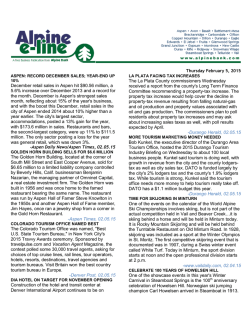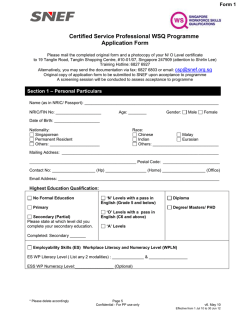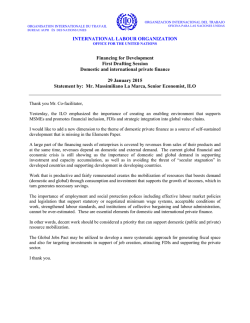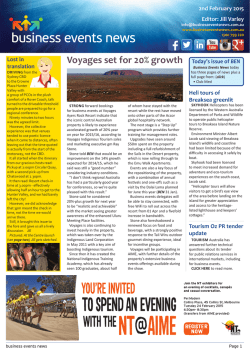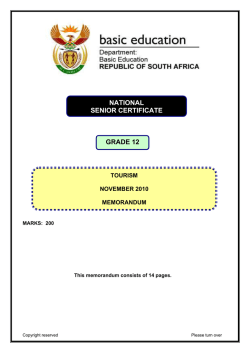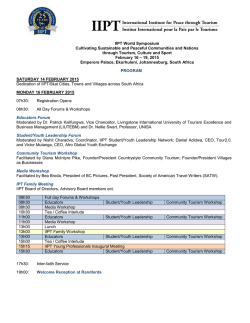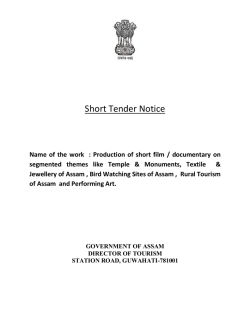
Skilled Occupation List (SOL) 2015-16
Skilled Occupation List (SOL) 2015-16 Tracking Code: RGDGBX Name Individual * Spiro Kavadias Organisation Australian Trade Commission (Austrade) What are the industry/industries and ANZSCO occupation/s that you or your organisation represents for the purposes of this submission? Industry Accommodation and Food Services Occupation The three dropdowns below accord with the ABS ANZSCO classification of occupations. Selections are required at the ‘Occupation Group’ 2-digit level and at the ‘Occupation Unit (4-digit)’ level, but can also be made down to the Occupation (6-digit) level depending on the occupation/s to which your submission relates. Additional occupations can be selected by way of the ‘Add item’ button. For each occupation selected, please indicate whether your advice is to Include, Exclude, or is Neutral (other) with respect to the 2015-16 SOL. The rest of the form can be used to provide evidence/reasons to support your recommendations. Attachments can also be added after clicking the 'Submit' button. Item 1 Page 1 of 7 Occupation Group * Hospitality, Retail and Service Managers Occupation Unit * Cafe and Restaurant Managers Occupation All Summary advice for 2015-16 SOL * Include Exclude Neutral Are there any occupations that you represent where there is evidence of imbalances in the demand for and supply of skills in the medium-to-long term? * The demand for skilled labour in the tourism and hospitality industry, particularly for Café and Restaurant Managers, will significantly outweigh supply in the medium to long term. The Australian Tourism Labour Force Report (Deloitte Access Economics, 2011) found that by 2015, an additional 56,000 people will be needed to fill vacancies (including 26,000 skilled positions) in the tourism industry. Café and Restaurant Managers represent the second highest occupation in terms of accumulated skilled labour shortages, with 3,114 additional people required to fill vacancies by 2015. The Department of Employment’s Job Outlook data shows that 63,100 people were employed as café and restaurant managers as at November 2013. Jobs Outlook estimates that this skilled occupation will experience ‘very strong growth’ over the next five years with ‘above average’ future job openings (based on Department of Employment projections). It estimates that over the five years to November 2018, the number of job openings for Café and Restaurant Managers is expected to be between 25,001 and 50,000. Inbound visitor arrivals to Australia are forecast to rise 5.7 per cent to 7.0 million in 2014-15, driven by growth in the Asian markets. Unfilled vacancies for Café and Restaurant Managers will limit the potential for growth of the visitor economy and impose costs on the broader Australian economy. A continued shortage of Café and Restaurant Managers will impose capacity constraints on the industry that will prevent it from fully servicing export demand. In some regional areas this skill shortage could limit the growth of businesses. It will also prevent the industry from fully leveraging its potential as an emerging global food and wine destination. Page 2 of 7 Inclusion of this category to the SOL will also support the Government’s labour and skills priority focus as part of its national tourism strategy Tourism 2020. Is there evidence of imbalances in the demand for and supply of skills in the medium-to-long term in non-metropolitan areas? If so, can you indicate in what part of Australia and the number in the occupation in over or undersupply. There is evidence of imbalances in the demand for and supply of skills in the medium to long term in regional locations. According to the Australian Tourism Labour Force Report by 2015, 568 skilled Café and Restaurant Managers will be needed in regional areas for unfilled vacancies. According to Tourism Research Australia (TRA), 45% of all tourism expenditure in Australia is spent in regional areas in 2013-14. There are regional areas in Australia whose economies rely disproportionately on tourism – the Australian average is 3.0 per cent. The TRA report, The Economic Importance of Tourism in Australia’s Regions, lists the top twenty regions according to their economic dependence on the tourism industry as a percentage of their total economy. The top five regions are: 1. Alice Springs/Central (NT): 24.8 per cent economic dependence on tourism 2. Phillip Island (VIC): 18.7 per cent 3. Whitsundays (QLD): 17.7 per cent 4. Snowy Mountains (NSW): 17.1 per cent 5. West Coast (TAS): 16.2 per cent. If these regions and other tourism dependent regions are unable to source the skills they require, it will have adverse effects on businesses’ ability to operate and is likely to lead to a disproportionate economic cost for these regions. Under Tourism 2020, the Australian Government is developing Tourism Employment Plans (TEPs) to address labour and skills pressures. Surveys conducted for the Broome TEP found that managers were in demand. Extensive industry consultation for the Red Centre TEP also found a shortage of skilled managers and the need for migration pathways to supplement the local labour force to address this shortage. The need for skilled migrant labour has also been a consistent theme as part of regional workforce planning for TEPs in Sydney, Mornington Peninsula and Phillip Island, and Tropical North Queensland. In the Australian Tourism Labour Force Report “accumulated skilled labour demand” refers to the total additional skilled workers required over a defined period of time after accounting for growth in demand and exit from the sector (e.g. through retirement and individuals leaving the tourism and hospitality workforce for other industries). For Café and Restaurant Managers the accumulated skilled labour demand by 2015 is highest in the following non-metropolitan tourism regions (top 10): 1. Mid North Coast, NSW (35) Page 3 of 7 2. 3. 4. 5. 6. 7. 8. 9. 10. Central Coast, NSW (32) Hunter, NSW (31) Peninsula, VIC (28) Sunshine Coast, QLD (26) Central NSW (23) Northern Rivers, NSW (21) Tropical North Queensland (21) South Coast, NSW (19) Geelong, VIC and Australia's South West, WA (both 18) Are there any occupations which require formal licensing or registration arrangements in order to practice/perform in this occupation? For example: • Midwives are required to register with the nurses board in their state or territory • Panelbeaters are required to be registered or certified with the state Motor Vehicle Repair Industry Authority Café and Restaurant Managers are required to have the necessary skills and knowledge to maintain a level of quality and service, including extensive on the job experience. To perform competitively in the industry, the following qualifications are required: Certificate IV, AQF Associate Degree, Advanced Diploma, or Diploma (ANZSCO Skill Level 2), with larger lead times to develop competencies that meet industry standards. They may also be required to hold the appropriate Responsible Service of Alcohol and / or Food Safety Supervisor certificates for the jurisdiction in which they are working. Is it expected that your employment sector will be impacted by any medium-to-long term trends which will impact upon demand and/or supply (excluding costs associated with training, labour hire, and international sponsorship)? Please provide evidence (e.g. data source, policy document) which substantiates these claims. For example: • New benchmarks for childcare centres mandate increased staff-to-child ratios and higher qualification standards for childcare workers. Tourism 2020 and tourism as a super sector Tourism is a major contributor to Australia’s economy, directly contributing $42 billion to gross domestic product in 2013-14. It also contributes significantly to the broader visitor economy and Page 4 of 7 regional Australia and is a major source of employment, directly and indirectly providing jobs for around one million people across the visitor economy. The Australian Government is committed to working with states, territories and industry to double overnight visitor expenditure to between $115 billion and $140 billion by 2020 as part of the national tourism strategy, Tourism 2020. One of Tourism 2020’s key priorities is filling labour and skills shortages to position the tourism industry to effectively service the needs of current and future global customers. The Government has identified tourism as one of five national investment priorities. In addition, the industry has been identified as one of five super growth sectors (Deloitte 2013). The demand for tourism services remains strong with record arrivals of 6.1 million international visitors in 2013-14 (an 8 per cent increase from 2012-13). Asian Century Tourism is a growth industry that is forecast to receive an increase in tourists from Asia over the next decade, with China alone forecast to provide around a fifth of total growth in tourism expenditure (international and domestic). Strong growth from Asia is vital to the performance of the inbound tourism sector in the short term and the longer term. According to Tourism Research Australia’s Tourism Forecasts, by 2022-23 Asia is expected to account for nearly half of all inbound arrivals (48 per cent), up from 43 per cent in 2013-14. Inbound visitor arrivals to Australia are forecast to rise 5.7 per cent to 7.0 million in 2014-15, driven by growth in the Asian markets. Arrivals from China are expected to increase 10.5 per cent, India 6.6 per cent and Singapore 5.8 per cent. The growth in inbound tourists will stimulate increased demand for skilled Café and Restaurant Managers to service visitors from Asia, a demand which could be difficult to satisfy without the inclusion of Café and Restaurant Managers on the Skilled Occupation List. Labour mobility The tourism and hospitality industry is experiencing similar issues in relation to labour and skills as the construction, mining and agriculture industries trying to source skilled labour in regional, remote and seasonal locations. Domestic labour sources are currently unwilling or unable to relocate to regional or remote areas in high labour demand. Allowing industry access to Café and Restaurant Managers under the Skilled Occupation List will provide tourism and hospitality businesses in these regions with the scope to source labour to help alleviate shortages and reduce capacity constraints. This would complement strategies being implemented under Tourism 2020 to support recruitment, retention and up-skilling of the domestic workforce particularly through the development of Tourism Employment Plans. Evidence Page 5 of 7 The Australian Tourism Labour Force Report (Deloitte Access Economics, 2011) http://www.austrade.gov.au/ArticleDocuments/5499/DAE-RET-Aus-Tourism-Labour-ForceReport-Pt-1.pdf.aspx Job Outlook (Department of Employment, 2014) http://joboutlook.gov.au/ The Economic Importance of Tourism in Australia’s Regions (Tourism Research Australia, 2011) http://corporate.snowymountains.com.au/wp-content/files/ The_Economic_Importance_of_Tourism_in_Australias_Regions_FINAL.pdf Tourism Forecasts (Tourism Research Australia, 2014) http://tra.gov.au/publications/forecasts-Tourism-Forecasts-Autumn-2014.html Geographic Labour Mobility (Productivity Commission, 2014) http://www.pc.gov.au/projects/study/labour-mobility Please provide any other information you consider relevant evidence to support your submission For example, you may know of some independent studies about your occupation that supports your advice to us. Deloitte Access Economics’ report “Positioning for Prosperity?” forecasts that Australia’s tourism sector will double in size in the next 20 years, making tourism the largest industry of the five new super sectors: tourism, agribusiness, international education, gas and wealth management. The 2020 Tourism Industry Potential highlights labour and skills as one of the greatest challenges to supply side issues in terms of growing the tourism industry. It is estimated that between 56,000 to 152,000 additional jobs will be needed by 2020. The ability to access highly qualified labour through the General Skilled Migration pathway including access to occupations on the Skilled Occupation List is an important complementary mechanism to support the government’s Tourism 2020 strategy. The inclusion of Café and Restaurant Managers on the SOL will assist in safeguarding against the current capacity constraints and missed economic opportunity for expected growth. Would you like to make any additional comments on the SOL? Page 6 of 7 Please provide the name, position and contact details of a person within your organisation who is willing to be contacted if any further information or follow-up is required. Name * Megan Street Position * Senior Policy Officer Contact details * Email: [email protected] Ph: 02 6272 6897 All information, including name and address details, contained in submissions will be made available to the public on the Department of Industry website unless you indicate that you would like all or part of your submission to remain in confidence. Automatically generated confidentiality statements in emails do not suffice for this purpose. Respondents who would like all or part of their submission to remain in confidence should provide this information in an email to SOL@industry. gov.au . Legal requirements, such as those imposed by the Freedom of Information Act 1982, may affect the confidentiality of your submission. Page 7 of 7
© Copyright 2026
